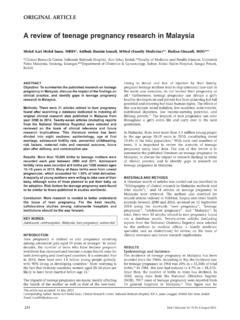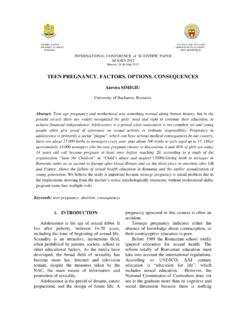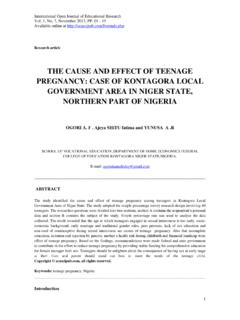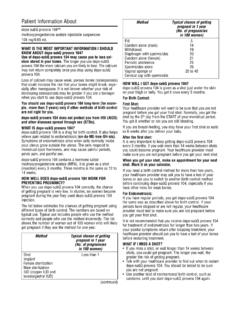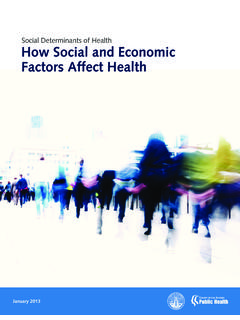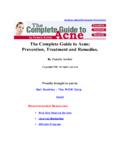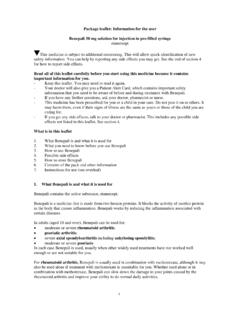Transcription of Fetal Alcohol Syndrome - FASlink
1 Education TCHP Consortium Fetal Alcohol Syndrome 12/2000 TCHP Education Consortium. All rights reserved. Copying without permission is forbidden. Synopsis Introduction Fetal Alcohol Syndrome (FAS) is the single largest cause As a former pediatric nurse I thought I knew quite a bit of mental retardation in the Western world. It is all the about Fetal Alcohol Syndrome . I had held and taken care more tragic given that FAS is the only congenital cause of of many kids in the hospital with this disorder. I thought it mental retardation that is 100% preventable. The cost to was a fairly rare disorder that seemed to strike deep in the society as well as the individuals and families dealing Native American community.
2 I started reading to prepare with this disorder is staggering. Why is it that it persists? to write this booklet and was shocked to find out what a Why is it that despite all that's known about FAS and the common and devastating disorder this is and that it knows less obvious but equally devastating Fetal Alcohol Effects no boundaries in terms of race, socioeconomic status, or (FAE), health care professionals are still not particularly educational level. Even "Minnesota nice" doesn't help--in savvy in this area? As health care professionals there is a 1995 Minnesota ranked 4th highest in the nation for lot we can do to educate our patients and connect families frequent drinking in women of childbearing age.
3 (1) After with resources to deal with this disorder. This booklet is a you are done reading this I hope you feel the same great step in the direction of educating yourself so you imperative I do to get the word out about the toxic effects can make a difference in the lives of the families you deal of Alcohol on a developing fetus. with. I wanted to put a "face" to this Syndrome , so I have Objectives created a fictitious character named Jill. Her story is a composite of cases and stories I have encountered along 1. Define Fetal Alcohol Syndrome (FAS) and Fetal the way. Alcohol Effects (FAE). 2. Describe the risk factors that can lead to FAS/E.
4 3. Identify five traits of a child with FAS/E. 4. Explain why the neurodevelopmental disorders that Let's Meet Jill . occur with FAS/E can be devastating. 5. Describe how the timing of prenatal Alcohol exposure Jill is the 19 year-old daughter of Bill and Kate, an upper during pregnancy affects the development of middle class couple living in an outer ring suburb. Jill disorders in the child. has always been a good student and is currently pre-law 6. Identify three ways that health care professionals can at the local college. Jill enjoys attending many parties decrease the impact of FAS/E. that are a part of the social life at her college.
5 What Jill 7. List three points to include in patient education with a doesn't know yet is that she is pregnant. family dealing with FAS/E. Continuing Education This learning activity has been designed to meet the What is Fetal Alcohol Syndrome Minnesota Board of Nursing continuing education and What are Fetal Alcohol requirements. A total of two and one-half ( ) contact Effects? hours may be obtained by completing this independent learning program. You are responsible for determining whether this activity meets the requirements for Fetal Alcohol Syndrome acceptable continuing education. Please follow the instructions at the end of this program to obtain a Fetal Alcohol Syndrome (FAS) More than 30% of certificate for continuing education completion.
6 Refers to a pattern of birth defects babies born to that may develop in children alcoholic mothers Author whose mothers drank Alcohol sustain enough Linda Checky, BSN, RN, MBA, is the Assistant during pregnancy. FAS is a damage from in Program Manager for TCHP Education Consortium. disability characterized by facial utero exposure to anomalies, low birth weight, Alcohol to be Editors mental handicaps or learning diagnosed with full disabilities, central nervous system FAS. (2). Karen Jones, RN, Educator, Regions Hospital. dysfunction (poor coordination, Nicki Kratoska, BSN, RN, Newborn ICU Clinical hyperactivity, attention problems, etc.)
7 , and varying Educator, Hennepin County Medical Center. degrees of damage or malfunction of internal organs. Richard C. Lussky, , Assistant Director of the NBICU, Hennepin County Medical Center, Assistant Professor of Pediatrics, University of Minnesota, and past member of the Governor's Task Force on FAS. Fetal Alcohol Syndrome 12/2000 TCHP Education Consortium Page 3. To receive a clinical diagnosis of FAS, deficits must be disorder, etc. that are related to prenatal exposure to seen in each of these three areas: Alcohol . 1. Growth retardation, either in utero or postnatally What is the Scope of the Problem? 2. CNS damage (irreversible brain damage, learning and behavioral disorders, deficits in memory and attention, hyperactivity, speech and language delays, FAS is the leading cause of mental retardation in the poor coordination) USA.
8 The incidence of FAS worldwide is cases per 3. Head and facial abnormalities (small head 1,000 births, a rate that is 20 times the rate of infantile circumference, abnormally small and widely spaced HIV. Figure 1 very graphically shows that FAS/E is far eyes, epicanthal folds, flat midface, short and and away a much more pervasive problem than HIV, upturned nose, smooth and wide philtrum, thin upper Spina Bifida, Muscular Dystrophy, or even Down's lip, underdeveloped jaw) Syndrome . Not all children with FAS are alike. Some will be more Figure 1: Incidence of FAS and FAE in the USA. severely affected than others and in different ways. Each Compared to Other Disorders (Duplicated with Permission: Better Endings/ New Beginnings).
9 Child will have his or her own special needs, problems, and potential. Fetal Alcohol Effects Children diagnosed with Fetal Alcohol Effects (FAE). have deficits in one or more areas previously mentioned. Their mothers were found to drink smaller daily amounts of Alcohol than mothers who had children with FAS. However, FAE is not a less severe form of FAS. Although children with FAE may lack the outward physical Alcohol damage to the fetus will vary greatly due to the appearance of Alcohol damage and generally have higher volume of Alcohol ingested, the time Alcohol is ingested IQs, the internal damage to the brain and other organs can during the pregnancy, peak blood Alcohol levels, genetics, be just as serious as full FAS.
10 It is estimated that the and environmental factors. All fetuses will suffer some incidence of FAE is 3-10 times that of those diagnosed effects because it takes very little Alcohol to cause serious with full FAS. The lack of specific criteria for FAE damage. Alcohol is toxic at all concentrations to a makes estimation of incidence and diagnosis difficult. developing fetus. In fact, the Surgeon General has warned that: There is no known safe level of Alcohol consumption during pregnancy.(3) It has been estimated Other Terms that more than 10% of children born have been exposed to high levels of Alcohol in utero. The lifetime cost of one baby with FAS could be as high as $4 million.


